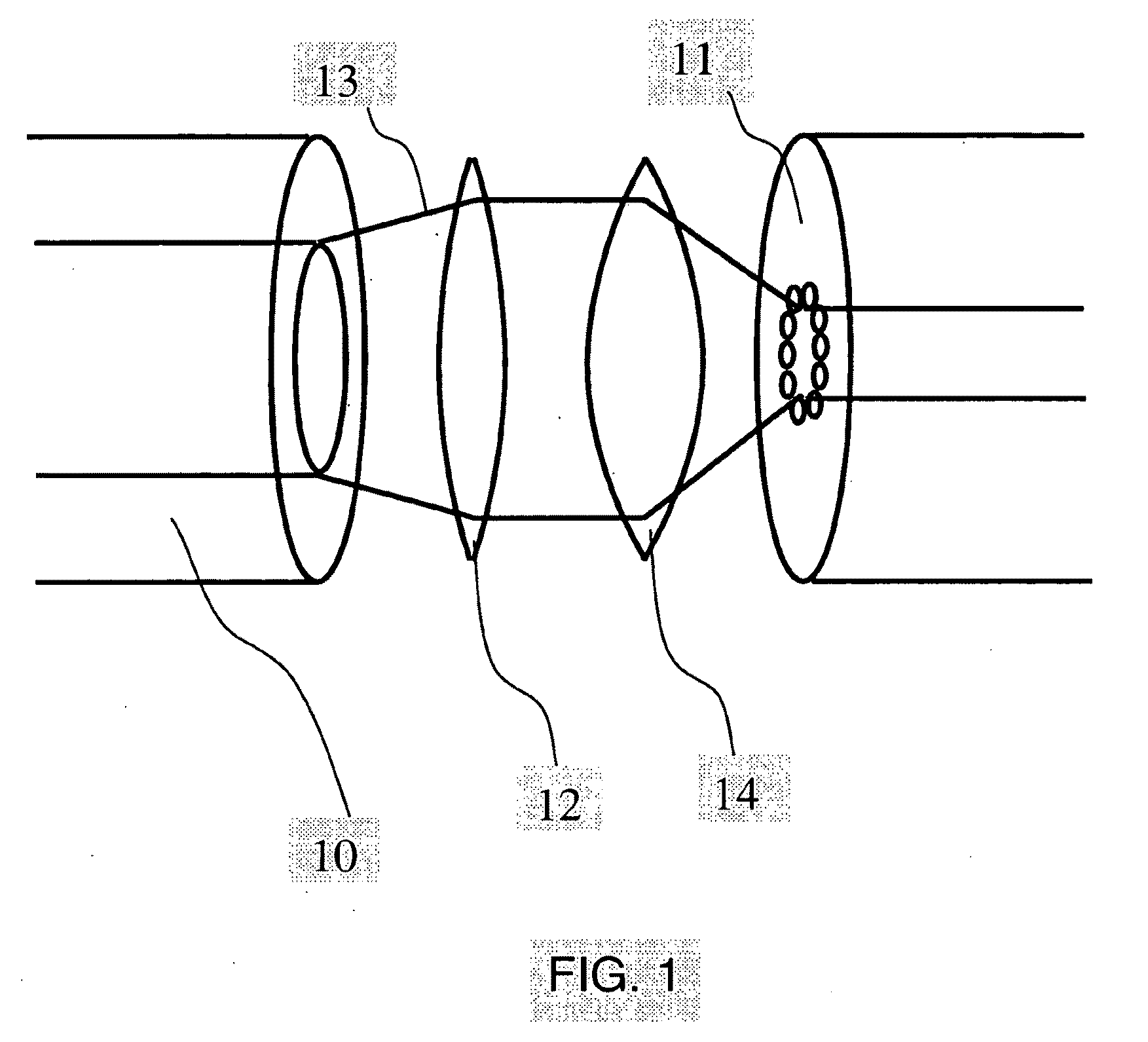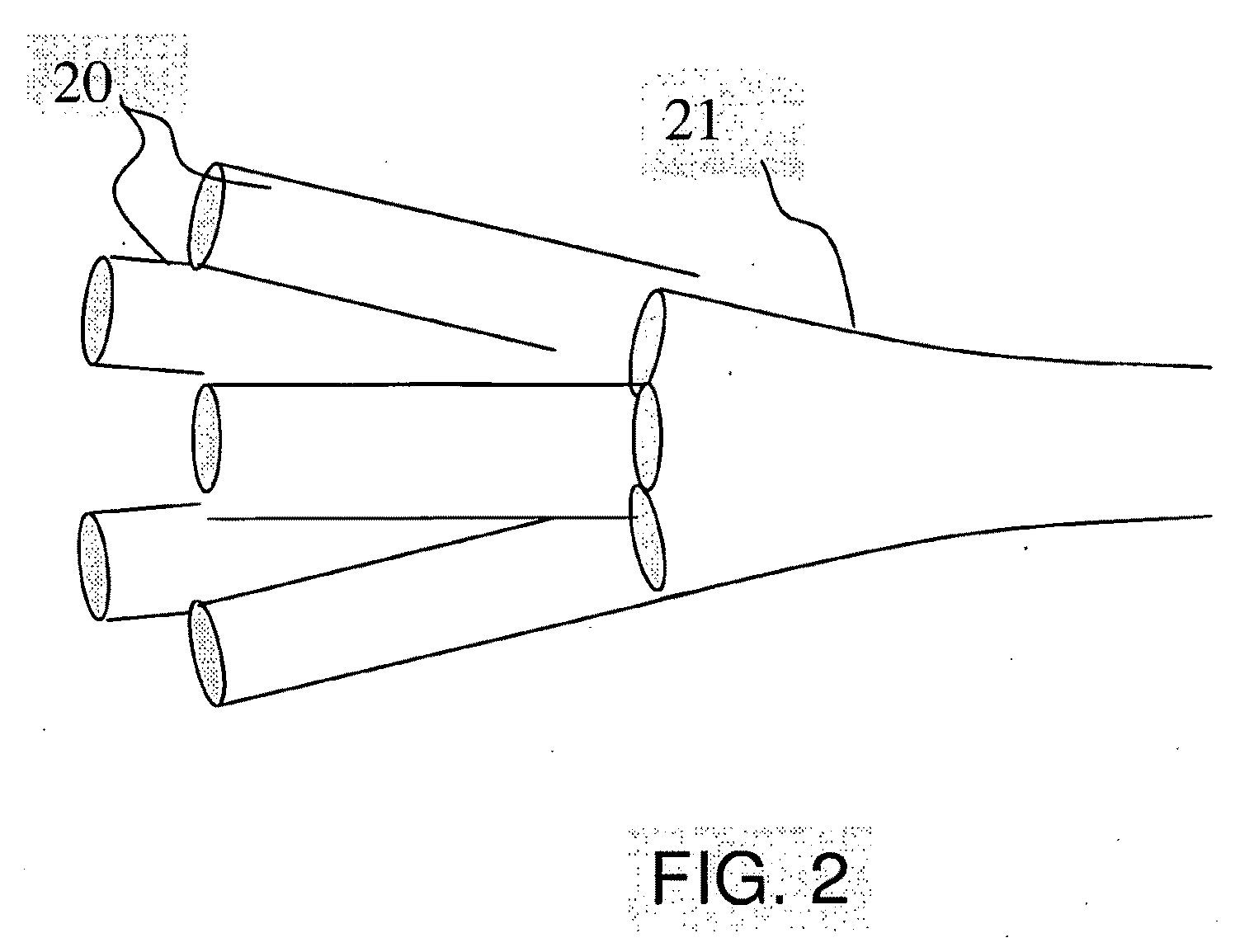Optical coupler devices, methods of their production and use
- Summary
- Abstract
- Description
- Claims
- Application Information
AI Technical Summary
Benefits of technology
Problems solved by technology
Method used
Image
Examples
example 1
Optical Component
[0170]FIG. 3 schematically shows an embodiment 30 of the present invention; FIG. 3a being a longitudinal view showing how pump light 35 is coupled to a high NA, double clad fibre (first fibre) 31 from an off axis co-directional pump fibre (second fibre) 32 via a reflective element (reflector element) 33 and signal light 36 is coupled out from the high NA, double clad fibre (first fibre) through the reflective element (the reflector element has a coating that provides high reflection of the pump light, but not of the signal light). The first and second fibre(s) are hold together in a mounting tube 34. The number of second fibres is typically 3, 6, 12, 18, but it can be any number, such as 3 or larger, such as 6 or larger. FIG. 3b shows a cross section of the optical component including the ends of the first and second optical fibres 31, 32 (here 7 pump fibres) and the mounting tube 34 (along plane AA′ in FIG. 3a) to which the reflector element 33 is optically coupled...
example 2
Optical Component
[0172]The following is a description of preferred realizations of a unit which acts as a combined pump combiner and coupler. Furthermore it is described how such a combiner can be used in the realization of a fibre laser where the unit acts as a combined pump combiner / coupler, high reflector and output coupler.
[0173]The example consists of a description of the following elements of an optical component: Reflective element, first (passive pump) and second (active) optical fibres and a fibre holding element for positioning the first and second optical fibres relative to each other as well as a description of the coupler assembly and applications.
Reflector Element: Bulk Optical Mirror
[0174]In this realization the reflective element consists of a plano-convex element 120 with a plane 122 and a spherical surface 121, cf. FIG. 12. The spherical surface 121 is coated with a reflective coating. Such a coating could be either a dielectric coating consisting of a stack of thi...
example 3
Optimization of a Non Rotational Symmetric Aspheric Reflector Element
[0213]This following describes a procedure for designing a reflective end-cap coupler (reflector element) with a given shape or profile of the reflecting end-facet to couple light from a pump delivery fibre (second fibre) into a double-clad fibre (first fibre).
[0214]In order to design a suitable reflector we consider a ray 443 leaving an end 422 of the pump fibre 42 (second end) and consider the criteria which has to be fulfilled for the ray 444 to hit the end 413 of the first fibre 41 (first end) at an angle β within the acceptance cone of the first fibre, cf. FIG. 4.
[0215]Consider a ray 443 leaving the center of the pump core 421 of the pump fibre 42 at the second end 422 with an angle (90-α) to the y axis determined by the NA of the fibre, (referred to as NApump or as NA2). The line can be described by
y=tan(sin−1NApump)x+d=m1x+d.
[0216]This ray has to be reflected by the surface 441 (an end-facet of the reflecto...
PUM
 Login to View More
Login to View More Abstract
Description
Claims
Application Information
 Login to View More
Login to View More - R&D
- Intellectual Property
- Life Sciences
- Materials
- Tech Scout
- Unparalleled Data Quality
- Higher Quality Content
- 60% Fewer Hallucinations
Browse by: Latest US Patents, China's latest patents, Technical Efficacy Thesaurus, Application Domain, Technology Topic, Popular Technical Reports.
© 2025 PatSnap. All rights reserved.Legal|Privacy policy|Modern Slavery Act Transparency Statement|Sitemap|About US| Contact US: help@patsnap.com



